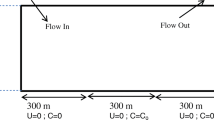Abstract
Rainwater can collect in a lens-shaped region within the rock of a tropical island, and may be separated from the underlying salt water by a sharp interface. This paper presents a nonlinear theory for determining the shape of this interface. The island is assumed to be saturated with rain, and provision is made for the outflow of rain-water through the sides of the island. The effect of a bore well on the shape of the interface is investigated, and the problem is solved using a spectral method. An integral-equation method is also presented for the case when the island has infinite width.
Similar content being viewed by others
References
E.O. Tuck and J.-M. Vanden-Broeck, A cusp-like free-surface flow due to a submerged source or sink. J. Austral.Math. Soc. Ser. B 25 (1984) 443–450.
G.C. Hocking and L.K. Forbes, A note on the flow induced by a line sink beneath a free surface. J. Austral. Math. Soc. Ser. B 32 (1991) 251–260.
L.K. Forbes and G.C. Hocking, Flow induced by a line sink in a quiescent fluid with surface-tension effects. J. Austral. Math. Soc. Ser. B 34 (1993) 377–391.
G.C. Hocking, Supercritical withdrawal from a two-layer fluid through a line sink. J. Fluid Mech. 297 (1995) 37–47.
L.K. Forbes and G.C. Hocking, Flow caused by a point sink in a fluid having a free surface. J. Austral. Math. Soc. Ser. B 32 (1990) 231–249.
L.K. Forbes and G.C. Hocking, On the computation of steady axi-symmetric withdrawal from a two-layer fluid. Comp. Fluids 32 (2003) 385–401.
J.R. Lister, Selective withdrawal from a viscous two-layer system. J. Fluid Mech. 198 (1989) 231–254.
T.J. Singler and J.F. Geer, A hybrid perturbation-Galerkin solution to a problem in selective withdrawal. Phys. Fluids Ser. A 5 (1993) 1156–1166.
M. Muskat, The Flow of Homogeneous Fluids Through Porous Media. New York: McGraw-Hill (1937) 763 pp.
J. Bear, Dynamics of Fluids in Porous Media. New York: Elsevier (1972) 764 pp.
G. Dagan, Flow and Transport in Porous Formations. Berlin: Springer-Verlag (1989) 465 pp.
S.K. Lucas, J.R. Blake and A. Kucera, A boundary-integral method applied to water coning in oil reservoirs. J. Austral. Math. Soc. Ser. B 32 (1991) 261–283.
S.K. Lucas and A. Kucera, A boundary integral method applied to the 3D water coning problem. Phys. Fluids 8 (1996) 3008–3022.
H. Zhang, G.C. Hocking and D.A. Barry, An analytical solution for critical withdrawal of layered fluid through a line sink in a porous medium. J. Austral. Math. Soc. Ser. B 39 (1997) 271–279.
L.K. Forbes, The design of a full-scale industrial mineral leaching process. Appl. Math. Modell. 25 (2001) 233–256.
T.S. Ma, M. Sophocleous, Y.-S. Yu and R.W. Buddemeier, Modeling saltwater upconing in a freshwater aquifer in south-central Kansas. J. Hydrology 201 (1997) 120–137.
E. Holzbecher, Modeling Density-Driven Flow in Porous Media. Berlin: Springer-Verlag (1998) 286 pp.
P.S. Huyakorn, Y.S. Wu and N.S. Park, Multiphase approach to the numerical solution of a sharp interface saltwater intrusion problem. Water Resources Res. 32 (1996) 93–102.
J.W. Bower, L.H. Motz and D.W. Durden, Analytical solution for determining the critical condition of saltwater upconing in a leaky artesian aquifer. J. Hydrology 221 (1999) 43–54.
C.D. Langevin, M.T. Stewart and C.M. Beaudoin, Effects of sea water canals on fresh water resources: an example from Big Pine Key, Florida. Ground Water 36 (1998) 503–513.
C. Ruppel, G. Schultz and S. Kruse, Anomalous fresh water lens morphology on a strip barrier island. Ground Water 38 (2000) 872–881.
H. Bouwer, Groundwater Hydrology.New York: McGraw-Hill (1978) 480 pp.
A.J. Raudkivi and R.A. Callander, Analysis of Groundwater Flow. London: Edward Arnold (1976) 214 pp.
H.I. Essaid, A comparison of the coupled fresh water-salt water flow and the Ghyben-Herzberg sharp interface approaches to modeling of transient behavior in coastal aquifer systems. J. Hydrology 86 (1986) 169–193.
D.A. Nutbrown, Optimal pumping regimes in an unconfined coastal aquifer. J. Hydrology 31 (1976) 271–280.
F. Padilla and J. Cruz-Sanjulián, Modeling sea-water intrusion with open boundary conditions. Ground Water 35 (1997) 704–712.
L.M. Delves and J.L. Mohamed, Computational Methods for Integral Equations. Cambridge: Cambridge University Press (1985) 339 pp.
R.S. Wikramaratna and W.L. Wood, Control of spurious oscillations in the salt water intrusion problem. Int. J. Numer. Meth. Eng. 19 (1983) 1243–1251.
M. Abramowitz and I.A. Stegun (eds.), Handbook of Mathematical Functions. New York: Dover (1972) 1046 pp.
J.A. Liggett and P. L.-F. Liu, The Boundary Integral Equation Method for Porous Media Flow. London: Allen and Unwin (1983) 255 pp.
Author information
Authors and Affiliations
Rights and permissions
About this article
Cite this article
Forbes, L.K., Hocking, G.C. & Wotherspoon, S. Salt-water up-coning during extraction of fresh water from a tropical island. Journal of Engineering Mathematics 48, 69–91 (2004). https://doi.org/10.1023/B:ENGI.0000009517.28682.6f
Issue Date:
DOI: https://doi.org/10.1023/B:ENGI.0000009517.28682.6f




